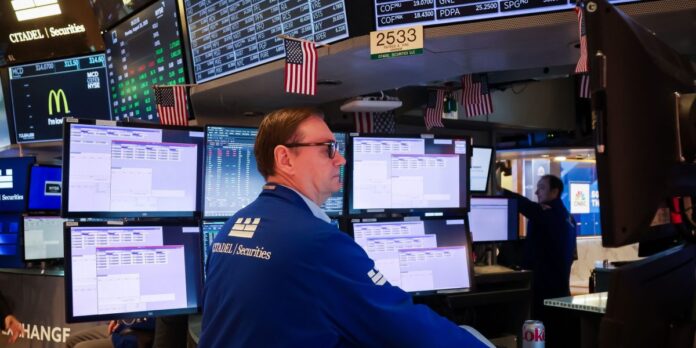The next few weeks will give Wall Street a clear reading on whether this latest stock market rally will continue — or if it’s doomed to get derailed.
Jobs reports, a key inflation reading and the Federal Reserve’s interest rate decision all hit over the next 14 trading sessions, setting the tone for investors as they return from summer vacations. The events arrive with the stock market seemingly at a crossroads after the S&P 500 Index just posted its weakest monthly gain since March and heads into September, historically its worst month of the year.
At the same time, volatility has vanished, with the Cboe Volatility Index, or VIX, trading above the key 20 level just once since the end of June. The S&P 500 hasn’t suffered a 2% selloff in 91 sessions, its longest stretch since July 2024. It touched another all-time high at 6,501.58 on Aug. 28, and is up 9.8% for the year after soaring 30% since its April 8 low.
“Investors are assuming correctly to be cautious in September,” said Thomas Lee, head of research at Fundstrat Global Advisors. “The Fed is re-embarking on a dovish cutting cycle after a long pause. This makes it tricky for traders to position.”
The long-time stock-market bull sees the S&P 500 losing 5% to 10% in the fall before rebounding to between 6,800 to 7,000 by year-end.
Eerie Calm
Lee isn’t alone in his near-term skepticism. Some of Wall Street’s biggest optimists are growing concerned that the eerie calm is sending a contrarian signal in the face of seasonal weakness. The S&P 500 has lost 0.7% on average in September over the past three decades, and it has posted a monthly decline in four of the last five years, according to data compiled by Bloomberg.
The major market catalysts begin to hit on Friday with the monthly jobs report. This data ended up in the spotlight at the beginning of August, when the Bureau of Labor Statistics marked down nonfarm payrolls for May and June by nearly 260,000. The adjustment set off a tirade by President Donald Trump, who fired the head of the agency and accused her of manipulating the data for political purposes.
After that, the BLS will announce its projected revision to the Current Employment Statistics establishment survey on Sept. 9, which may result in further adjustments to expectations for jobs growth.
Then inflation takes the stage with the consumer price index report arriving on Sept. 11. And on Sept. 17, the Fed will give its policy decision and quarterly interest-rate projections, after which Chair Jerome Powell will hold his press conference. Investors will be looking for any roadmap Powell provides for the trajectory of interest rates. Swaps markets are pricing in roughly 90% odds that the Fed will cut them at this meeting.
Two days later comes “triple witching,” when a large swath of equity-tied options expire, which should amplify volatility.
That’s a lot of uncertainty to process. But traders seem oddly unconcerned about this crucial stretch of data and decisions. Hedge funds and large speculators are shorting the Cboe Volatility Index, or VIX, at rates not seen in three years in a bet the calm will last. And jobs day has a forward implied volatility reading of just 85 basis points, indicating the market is underpricing that risk, according to Stuart Kaiser, Citigroup’s head of US equity trading strategy.
Turbulence Risk
The problem is, this kind of tranquility and extreme positioning has historically foreshadowed a spike in turbulence. That’s what happened in February, when the S&P 500 peaked and volatility jumped on worries about the Trump administration’s tariff plans, which caught pro traders off-sides after coming into 2025 betting that volatility would stay low. Traders also shorted the VIX at extreme levels in July 2024, before the unwinding of the yen carry trade upended global markets that August.
The VIX climbed toward 16 on Friday after touching its lowest levels of 2025, but Wall Street’s chief fear gauge still remains 19% below its one-year average.
Of course, there are fundamental reasons for the S&P 500’s rally. The economy has stayed relatively resilient in the face of Trump’s tariffs, while Corporate America’s profit growth remains strong. That’s left investors the most bullish on US stocks since they peaked in February, with cash levels historically low at 3.9%, according to Bank of America’s latest global fund manager survey.
But here’s the circular problem: As the S&P 500 climbs higher, investors become increasingly concerned that it is overvalued. The index trades at 22 times analysts’ average earnings forecast for the next 12 months. Since 1990, the market was only more expensive at the height of dot-com bubble and the technology euphoria coming out of the depths of the Covid pandemic in 2020.
“We’re buyers of big tech,” said Tatyana Bunich, president and founder of Financial 1 Tax. “But those shares are very pricey right now, so we’re holding some cash on the sidelines and waiting for any decent pullback before we add more to that position.”
Another well-known bull, Ed Yardeni of eponymous firm Yardeni Research, is questioning whether the Fed will even cut rates in September, which would hit the stock market hard, at least temporarily. His reason? Inflation remains a persistent risk.
“I expect this stock rally to stall soon,” Yardeni said. “The market is discounting a lot of happy news, so if CPI is hot and there’s a strong jobs report, traders suddenly may conclude rate cuts aren’t necessarily a done deal, which may lead to a brief selloff. But stocks will recover once traders realize the Fed can’t cut rates by much because of a good reason: The economy is still strong.”


